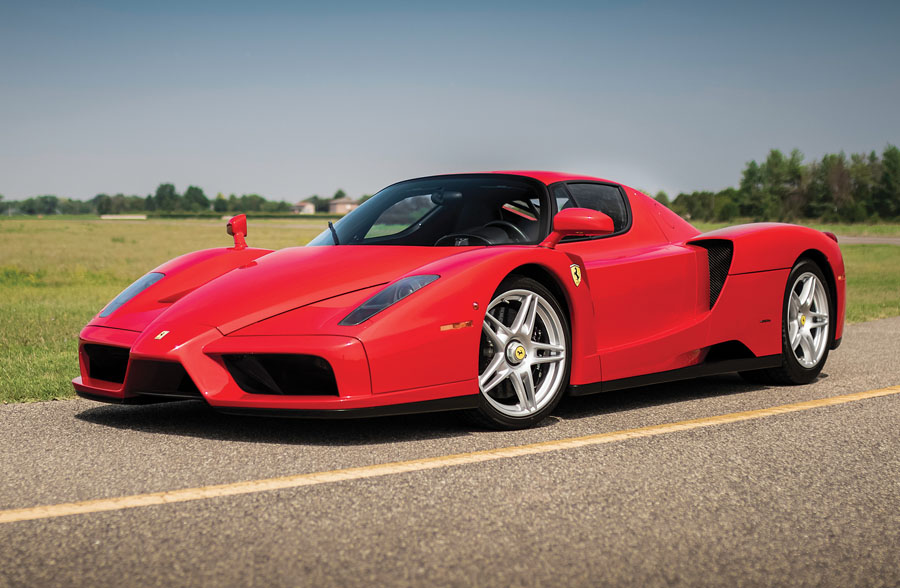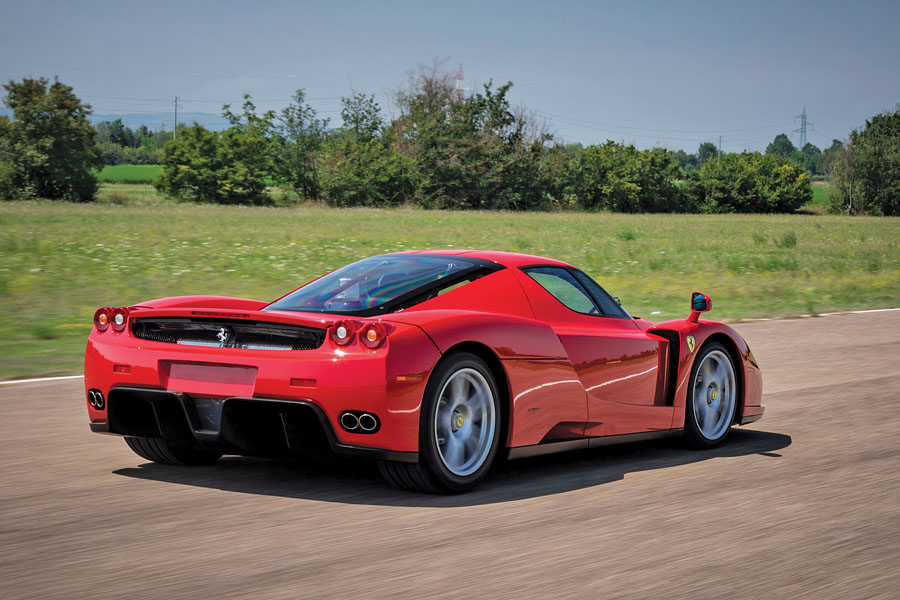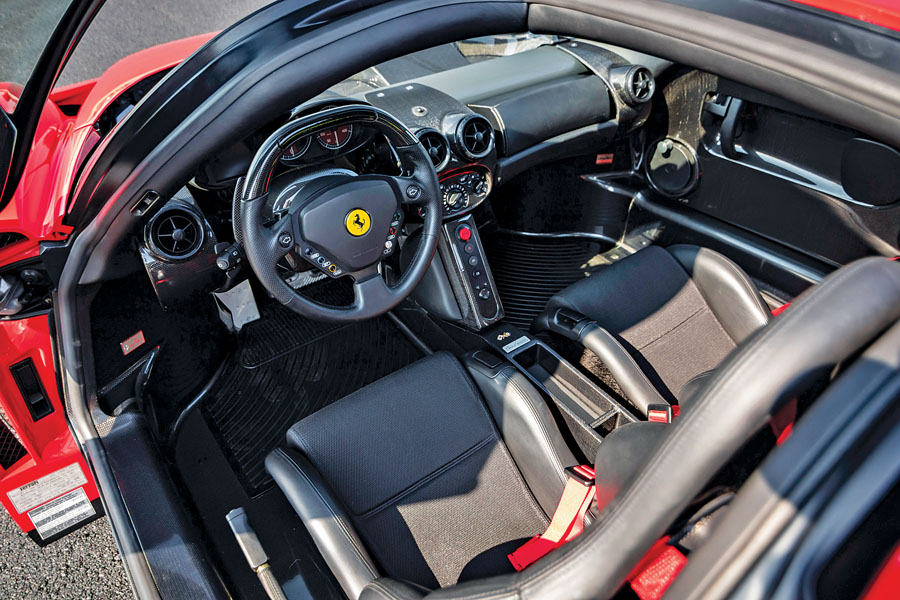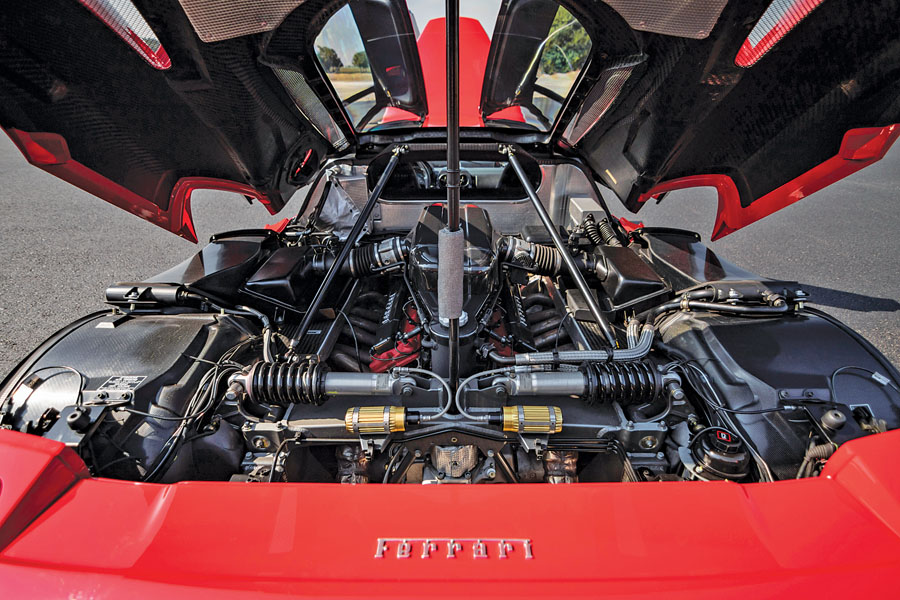SCM Analysis
Detailing
| Vehicle: | 2003 Ferrari Enzo |
| Years Produced: | 2003–05 |
| Number Produced: | 400 |
| Original List Price: | $643,330 |
| SCM Valuation: | $2,530,000 |
| Tune Up Cost: | Starts at $3,000 and can go up dramatically |
| Chassis Number Location: | Interior dash near windshield |
| Engine Number Location: | In V between heads |
| Club Info: | Ferrari Club of America, Ferrari Owners Club |
| Website: | http://www.ferrariclubofamerica.org |
| Alternatives: | 2006–11 Bugatti Veyron, 2013–15 Porsche 918, 2014–16 McLaren P1 |
| Investment Grade: | B |
This car, Lot 156 sold for $2,530,774, including buyer’s premium, at RM Sotheby’s London, U.K., sale on September 15, 2018.
I would have liked to have been in the room when suggestions were being made on naming the Enzo. Naming a model after the company’s founder is like a rock band dropping a greatest hits album. Is it the right time? Does it signal the end of an era? What do you do to top it? You could probably hear a pin drop as the name Ferrari Enzo was pondered, but someone must have made a strong argument, as the suggestion prevailed.
Luca di Montezemolo, president of Ferrari at the time, took credit for the name when introducing the model: “The third millennium has begun, with Ferrari enjoying a period of great competitiveness on the world’s racing circuits; in fact, Formula One has never offered the company so authentic a laboratory for advance research as it has in recent years. To bring together our racing success and the fundamental role of races, I decided that this car, which represents the best of which our technology is capable, should be dedicated to the founder of the company, who always thought racing should lay the foundation for our road-car designs. And so this model, of which we are very proud, will be known as the… Enzo Ferrari.”
Ken Okuyama is credited with the shape of the Enzo. Born in Japan, Okuyama honed his skills at the ArtCenter College of Design in Pasadena, CA, an institution that was also important to the careers of Chris Bangle, Gordon Buehrig, Wayne Cherry, Henrik Fisker and many more.
After graduating from the ArtCenter, Okuyama drifted through several notable positions before founding a namesake Industrial Design Company in his home country. One of the stops was Pininfarina, where he was assigned the Enzo project.
From racetrack to road
Ferrari road cars always feature technology trickled down from racing experience. Montezemolo wanted the Enzo to not just feature racing technology — he wanted it to embody the racing experience. Michael Schumacher had brought Formula One glory back to the Scuderia, and the Enzo was to celebrate the jubilation.
Okuyama ran with the concept. The Enzo’s nose features a distinctive triangular center with a low and wide end cap. The reference to a Formula One car’s nose and front wing is unmistakable. The side profile contrasts the wide front and rear fenders with a narrower center again hinting at the profile of a Formula car. The gullwing doors have nothing to do with the race car, but they confirm the exotic nature of the Enzo and separate it from other Ferraris.
The interior of the Enzo builds on a theme found in the F40 and F50. Their interiors were functional and race-car stark. The Enzo added beauty to the starkness in the form of finish and detail. The first thing you notice in an Enzo interior is the carbon fiber. It is everywhere, and it glistens like a polished jewel. Next you see the steering wheel, a technical and visual masterpiece.
The Enzo interior is set apart from the F40 and F50 by the use of color. While the earlier cars lightened the mostly black interiors with red or red-highlighted seats, Okuyama splashed red throughout the interior. There’s red on the seats, doors, dash and center console. Even the gauges have red faces. The result makes the interior stylish rather than just functional.
Big power
Ferraris are about engines, and the Enzo does not disappoint. We forget that 300 hp was a big number not long ago, and 500 hp was unheard of in a street car. The Enzo has 651 hp. Admittedly a couple of other cars may have had the same or more power, but they did not have the flexibility of the Enzo.
The Enzo is all about torque — the kind of power that catapults you out of a corner without having to downshift. It takes big displacement to make big torque, and the 6-liter Enzo had the largest displacement of any street Ferrari built up to that time. Variable valve timing, sophisticated engine management computers, and a variable-geometry inlet manifold, borrowed from Formula One, made sure the displacement wasn’t wasted.
No detail to the Enzo’s performance was ignored. Carbon brakes, aerodynamic aids, high-tech suspension and precision-tuned exhaust all contribute to the cause, but the transmission was considered the breakthrough. Ferrari stated, “The priority goal of the Enzo Ferrari project was to cut gear-change times in the interest of extremely sporty use.” Using a paddle-shift electro-hydraulic transmission with new synchronizers, twin-plate clutch and improved software, the Enzo’s shifts are nearly imperceptible and happen at a speed impossible to obtain with manual shifting.
A right car
RM Sotheby’s car was exactly what you would want if you were looking for an Enzo. It was a one-owner car with around 4,000 miles. It came with all the original goodies as well as a fresh $16,000 service by the closest dealer to the factory. It was reported to be in exceptional condition.
Appreciation put roughly $1,000,000 in the Enzo seller’s pocket over the original purchase price, assuming he paid list price, which should have been the case. The windfall came mostly from the owner being on good terms with Ferrari and acquiring the car at list price. The new owner will not do nearly as well.
Enzo prices have been stable for the past few years. They seldom sell under $2,000,000 and top out just below $3,000,000. Selling at $2.5 million, 134951 hit the Enzo sweet spot and was right on the median SCM Pocket Price Guide number.
Bugatti, Pagani and Koenigsegg are making multimillion-dollar supercars seem almost common. Special issues from Mercedes and McLaren or any of the big players are sold out almost as soon as they are announced. The number of supercar collectors keeps growing, but the number of Enzos doesn’t. There are only 400 Enzos in the world and there will never be more.
These are must-have cars for collectors of modern Ferraris, and that’s enough to keep demand — and prices — high. ♦
(Introductory description courtesy of RM Sotheby’s.)



